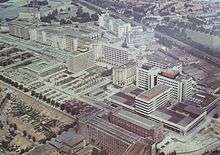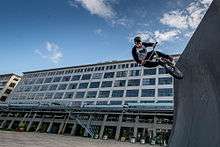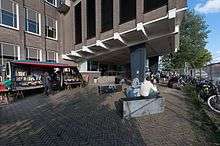Strijp-S
Strijp-S is a neighborhood and former industrial park in the Eindhoven district of Strijp. The area belonged to electronics company Philips. Since 2000, creative companies and housing have been established in the former industrial buildings. Eindhoven Strijp-S railway station serves the district.
Name
The name Strijp-S comes from the naming pattern that Philips used in its industrial parks. Strijp-S was the first park, and Strijp-T and Strijp-R followed.[1]
History
Lamps, radios and televisions
In 1916 Anton Philips built the first factory in Strijp-S a glass factory for incandescent light bulbs. The Philips Natuurkundig Laboratorium was completed in 1923. Strijp-S was where first radios, then televisions were invented and produced, as well as many other devices. The credo Van zand tot klant ("from sand to customer") stood behind the idea that Philips controlled every phase of production from research to storage, from glass blowing to cardboard factory: everything on one enormous piece of land.

Departure of Philips
In the 1990s Philips gradually left Eindhoven and in 2000 the first discussions took place about the repurposing of Strijp-S. In 2002 the land was sold for €140 million to Park Strijp Beheer B.V., a public private partnership between the city of Eindhoven and VolkerWessels. Philips was able to lease some of the buildings back temporarily until its full withdrawal in 2006, although there are still two small Philips departments present in the buildings SFH en SEY.
Adaptive reuse and Strijp-S today
Project for adaptive reuse
With the departure of Philips the plans was implemented to make the area a broad destination for the creative sector, including technology and design, under the English headline Old Buildings, New Ideas. The old factory buildings would be perfect for studios. In 2016 the creative school St. Lucas opened at Strijp-S.[2]

Residential
In 2012 Strijp-S got its first permanent residents, when the SAS-3 project was completed (new construction). A year later the repurposed industrial SAN en SBP buildings were ready for residential use. Lofts replaced former television factories. The buildings were renamed GERARD and ANTON, in honor of two prominenta members of the Philips family. Many other residential complexes are planned such as Space-S and Blok 61, 63 and 59.[3] A year later the industrial buildings SAN and SBP were also ready for residential use.[4][5]
The profile of the residents skews very young, with 78.2% of the residents are between 20 and 34 versus 24.6% in Eindhoven as a whole.[6]
Restaurants, cafés, bars
In the Veemgebouw in 2015 the food hall Vershal Het Veem opened.
Arts and culture
Art space MU and film house Plaza Futura are located at Strijp-S.
De Ontdekfabriek is a children's science discovery space. The Chinees Paviljoen is under construction, with a theme of Chinese culture, a gift from the Chinese city of Nanjing.
Events
Strijp-S is a major event space, in the halls of the Klokgebouw building, but also larger events on the Ketelhuisplein plaza. For example, dance festival Flying Dutch in 2015 attracted 25,000 visitors.[7] Dutch Design Week takes place each October. Every third Sunday of the month Strijp-S hosts the FeelGood Markt market.

Sports
Strijp-S is a magnet for urban sports. Skateboarding, BMX and bouldering as well as bootcamp classes.

Light Art
Strijp-S is a place for experimentiation with LED lighting, which keeps the historic connection with Philips' past.[8] Some light art includes the project Fakkel by Har Hollands. In the underground passage to NatLab artist Daan Roosegaarde installed his project Crystal.
Strijp-S is a regular location for the light festival GLOW.[9][10]
Points of interest

- Philips Natuurkundig Laboratorium or NatLab[11]
- Klokgebouw ("Clock building")
- Hoge Rug. Three industrial buildings from 1927, 1929 and 1930
- Ketelhuis ("Kettle House") and Machinekamer ("Machine Room") from 1929.
- Veemgebouw ("Warehouse Building") from 1942 where tvs, radios and other items were warehoused.
- Leidingstraat ("Cable Street"). A network of cables ten meters high where once gas and other liquids flowed. Here is a garden by Piet Oudolf, and the light art by Har Hollands.
- Torenallee ("Tower Avenue"). A wide boulevard for strolling.
- SPACE-S. 7 colorful residential blocks decorated by the residents themselves, 402 residences in total.
Official website
References
- 'Station Beukenlaan in Eindhoven heet voortaan Strijp-S', Eindhovens Dagblad.
- 'Bouw SintLucas op Strijp-S Eindohven start donderdagmiddag', Eindhovens Dagblad.
- 'Verboden stad mooi stukje Eindhoven', Eindhovens Dagblad.
- Redactie (1 februari 2013): 'Eerste loftbewoners nemen hun intrek', Eindhovens Dagblad.
- 'Bouwkranen domineren skyline Strijp-S', Eindhovens Dagblad.
- eindhoven.buurtmonitor.nl
- '25.000 mensen gaan los op The Flying Dutch in Eindhoven', Omroep Brabant.
- 'Lichtproject op Strijp-S pakt Auroralia Award in Lyon', Eindhovens Dagblad.
- 'Herbeleef Glow Eindhoven: Routes en hoogtepunten door de jaren heen', Eindhovens Dagblad.
- 'Licht zien, voelen en zelfs opslaan op Glow Next', Eindhovens Dagblad.
- 'Philips' Natlab: Proeftuin van de vooruitgang', NPO Geschiedenis.